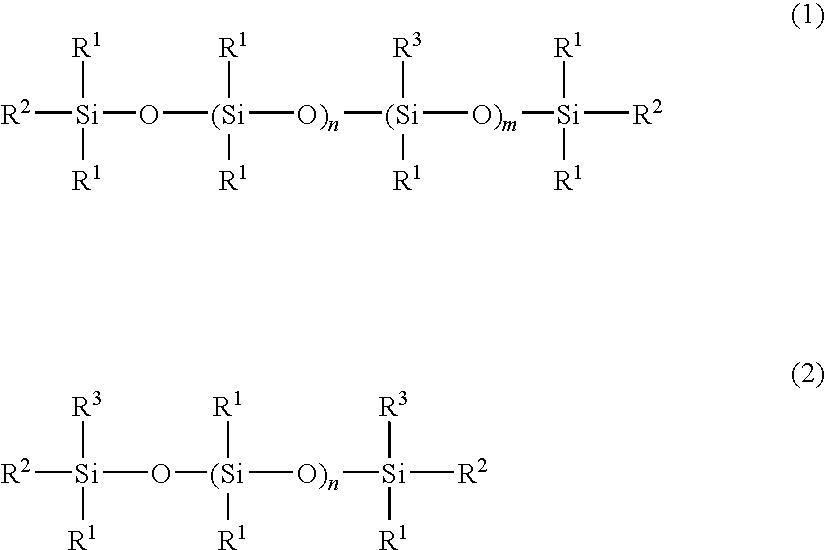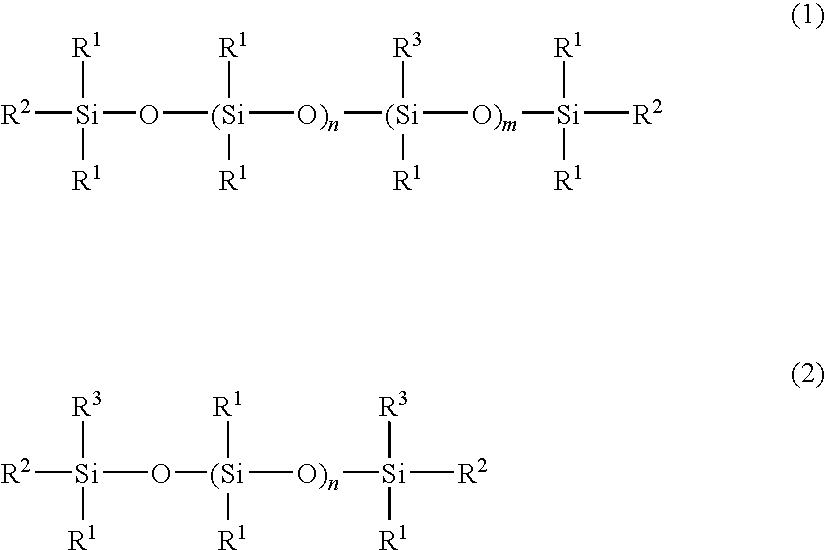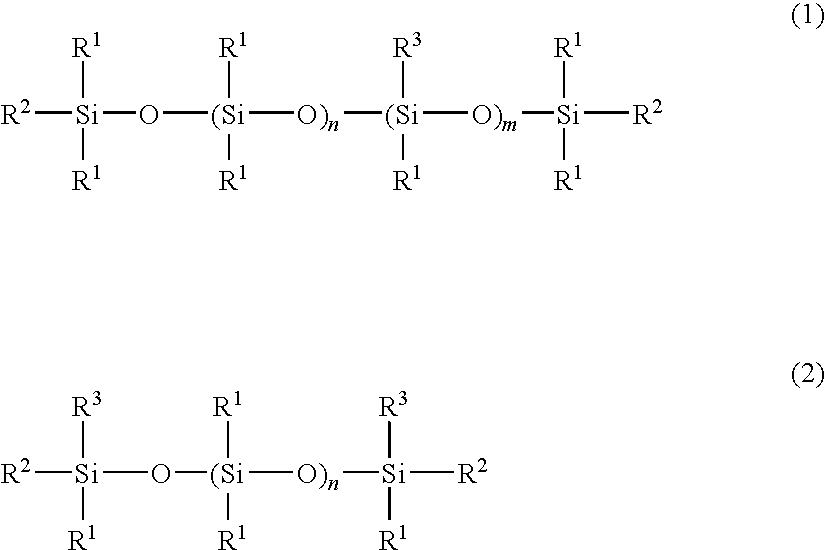Cosmetic hair preparation
a hair and cosmetic technology, applied in the field of cosmetic hair preparations, can solve the problems of greasy and bristly feeling on use, improved silkiness and smoothness of silicone compounds, and insufficient us
- Summary
- Abstract
- Description
- Claims
- Application Information
AI Technical Summary
Benefits of technology
Problems solved by technology
Method used
Image
Examples
preparation example 1
[0057]A four-neck separable flask of 1000-ml volume equipped with a thermometer, stirrer, reflux condenser, and nitrogen gas inlet tube was charged with 400 g of an amino-containing organopolysiloxane of the following formula (A) (viscosity 1,800 mPa-s, amine equivalent 3,800 g / mol), 120 g (corresponding to 5-fold moles relative to entire NH groups in the amino-containing organopolysiloxane) of ε-caprolactone of the following formula (5) (molecular weight 114), 300 g of toluene, and 0.2 g of a titanium base catalyst (tetrabutoxytitanium, TBT100 by Nippon Soda Co., Ltd., same hereinafter). The flask was purged with nitrogen gas and closed, after which reaction was allowed to run at 110° C. for 5 hours. After the completion of reaction, a low-boiling fraction was removed under a vacuum of 10 mmHg at 80° C. for 1 hour, yielding 495 g of an oily matter having a pale yellow clear appearance, a viscosity of 230,000 mPa-s (25° C.), and an amine equivalent unmeasurable. The structure of the...
preparation example 2
[0058]A four-neck separable flask of 1000-ml volume equipped with a thermometer, stirrer, reflux condenser, and nitrogen gas inlet tube was charged with 200 g of an amino-containing organopolysiloxane of the following formula (B) (viscosity 1,300 mPa-s, amine equivalent 1,700 g / mol), 100 g (corresponding to 5-fold moles relative to entire NH groups in the amino-containing organopolysiloxane) of ε-caprolactone of formula (5) (molecular weight 114), 300 g of toluene, and 0.2 g of the titanium base catalyst. The flask was purged with nitrogen gas and closed, after which reaction was allowed to run at 110° C. for 5 hours. After the completion of reaction, a low-boiling fraction was removed under a vacuum of 10 mmHg at 80° C. for 1 hour, yielding 280 g of an oily matter having a pale yellow clear appearance, a viscosity of 55,000 mPa-s (25° C.), and an amine equivalent of 5,400 g / mol. The structure of the oily matter was examined by nuclear magnetic resonance spectroscopy (1H-NMR), gel p...
preparation example 3
[0059]A four-neck separable flask of 1000-ml volume equipped with a thermometer, stirrer, reflux condenser, and nitrogen gas inlet tube was charged with 200 g of an amino-containing organopolysiloxane of the following formula (C) (viscosity 110 mPa-s, amine equivalent 1,550 g / mol), 120 g (corresponding to 4-fold moles relative to entire NH groups in the amino-containing organopolysiloxane) of ε-caprolactone of formula (5) (molecular weight 114), 300 g of toluene, and 0.2 g of the titanium base catalyst. The flask was purged with nitrogen gas and closed, after which reaction was allowed to run at 110° C. for 5 hours. After the completion of reaction, a low-boiling fraction was removed under a vacuum of 10 mmHg at 80° C. for 1 hour, yielding 510 g of an oily matter having a pale yellow clear appearance, a viscosity of 5,800 mPa-s (25° C.), and an amine equivalent unmeasurable. The structure of the oily matter was examined by nuclear magnetic resonance spectroscopy (1H-NMR), gel permea...
PUM
| Property | Measurement | Unit |
|---|---|---|
| mol % | aaaaa | aaaaa |
| mol % | aaaaa | aaaaa |
| weight | aaaaa | aaaaa |
Abstract
Description
Claims
Application Information
 Login to View More
Login to View More - R&D
- Intellectual Property
- Life Sciences
- Materials
- Tech Scout
- Unparalleled Data Quality
- Higher Quality Content
- 60% Fewer Hallucinations
Browse by: Latest US Patents, China's latest patents, Technical Efficacy Thesaurus, Application Domain, Technology Topic, Popular Technical Reports.
© 2025 PatSnap. All rights reserved.Legal|Privacy policy|Modern Slavery Act Transparency Statement|Sitemap|About US| Contact US: help@patsnap.com



